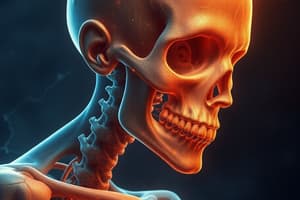Podcast
Questions and Answers
What can a deficiency of growth hormone during bone formation cause? (Select all that apply)
What can a deficiency of growth hormone during bone formation cause? (Select all that apply)
- Inadequate calcification of bone (correct)
- Decreased proliferation of the epiphyseal plate cartilage (correct)
- Decreased osteoclast activity
- Increased osteoclast activity
Which of the following is a bone projection?
Which of the following is a bone projection?
- Sinus
- Foramen
- Trochanter (correct)
- Fossa
- Groove
A fracture in the shaft of a bone would be a break in the ______.
A fracture in the shaft of a bone would be a break in the ______.
diaphysis
Match the following bone terms with their corresponding definitions:
Match the following bone terms with their corresponding definitions:
A step in what bone-forming process is shown in the figure?
A step in what bone-forming process is shown in the figure?
The indicated blood vessels and nerve are found within a ______.
The indicated blood vessels and nerve are found within a ______.
The process of bones increasing in width is known as ______.
The process of bones increasing in width is known as ______.
Hematopoiesis refers to the formation of blood cells within the red marrow cavities of certain bones.
Hematopoiesis refers to the formation of blood cells within the red marrow cavities of certain bones.
What is osteoid?
What is osteoid?
The osteon is ______.
The osteon is ______.
Normal bone formation and growth are dependent on the adequate intake of ______.
Normal bone formation and growth are dependent on the adequate intake of ______.
Cartilage grows in two ways, appositional and interstitial. What is appositional growth?
Cartilage grows in two ways, appositional and interstitial. What is appositional growth?
Bones are classified by whether they are weight bearing or protective in function.
Bones are classified by whether they are weight bearing or protective in function.
In the epiphyseal plate, cartilage grows ______.
In the epiphyseal plate, cartilage grows ______.
Which of the following is the single most important stimulus for epiphyseal plate activity during infancy and childhood?
Which of the following is the single most important stimulus for epiphyseal plate activity during infancy and childhood?
Which of the following glands or organs produces hormones that tend to decrease blood calcium levels?
Which of the following glands or organs produces hormones that tend to decrease blood calcium levels?
The main role of the appendicular skeleton is to protect and support vital organs.
The main role of the appendicular skeleton is to protect and support vital organs.
In adults, yellow marrow is located ______.
In adults, yellow marrow is located ______.
Bones are constantly undergoing resorption for various reasons. Which of the following cells accomplishes this process?
Bones are constantly undergoing resorption for various reasons. Which of the following cells accomplishes this process?
The above figure depicts which of the following bone-forming processes?
The above figure depicts which of the following bone-forming processes?
The notable hardness of bone is attributed to ______.
The notable hardness of bone is attributed to ______.
Flashcards are hidden until you start studying
Study Notes
Growth and Bone Formation
- A deficiency of growth hormone leads to decreased proliferation of epiphyseal plate cartilage.
- Bones can grow wider through appositional growth, where new matrix is secreted against existing cartilage.
- Hematopoiesis is the formation of blood cells in the red marrow cavities of certain bones.
Bone Anatomy and Projections
- A fracture in the shaft of a bone occurs in the diaphysis.
- Trochanter is classified as a bone projection.
- Essential bone structures include the osteon, which is the structural unit of compact bone.
Bone Development Processes
- Endochondral ossification is a vital process in bone formation.
- Intramembranous ossification occurs during embryonic development.
- Normal bone formation requires adequate intake of calcium, phosphate, and vitamin D.
Cartilage Growth
- Cartilage grows through two mechanisms: appositional and interstitial growth.
- Appositional growth involves the secretion of new matrix on the external face of existing cartilage.
Bone Composition and Function
- Osteoid refers to the organic part of the bone matrix.
- The remarkable hardness of bone arises from the presence of inorganic hydroxyapatites.
- Osteoclasts are responsible for the resorption of bone, making it a dynamic tissue.
Epiphyseal Plate and Hormonal Influence
- In the epiphyseal plate, cartilage grows by pushing the epiphysis away from the diaphysis.
- Growth hormone is the primary stimulus for epiphyseal plate activity during infancy and childhood.
Bone Marrow and Skeleton Function
- Yellow marrow is found in the medullary cavity of long bones in adults.
- The appendicular skeleton primarily supports movement rather than protection of vital organs.
Calcium Regulation
- The thyroid gland produces hormones that decrease blood calcium levels, contrasting with parathyroid hormone which increases it.
- Bone classification is not solely based on weight-bearing or protective functions, debunking a common misconception.
True/False Statements
- Bones are not classified purely by their weight-bearing or protective properties.
- The main role of the appendicular skeleton is not protection and support of vital organs.
Studying That Suits You
Use AI to generate personalized quizzes and flashcards to suit your learning preferences.




